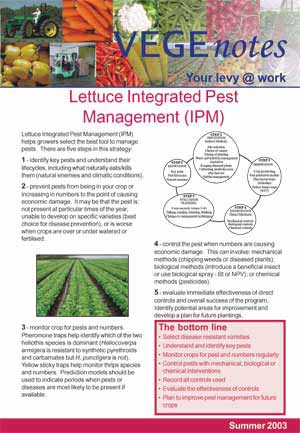|
Integrated Pest Management (IPM)
helps growers select the best tool to manage
pests.
There are five steps in this strategy:
-
IDENTIFY key pests and understand their
lifecycles, including what naturally eats/kills
them – natural enemies and climatic conditions.
-
PREVENT pests from being in your crop or
increasing in numbers to the point of causing
economic damage. It may be that the pest is:
not present at particular times of the year,
unable to develop on specific varieties – best
choice for disease prevention -, or is worse
when crops are over or under watered or
fertilised.
-
MONITOR crop for pests and numbers.
Pheromone traps help identify which of the two
heliothis species is dominant.
Yellow sticky traps help monitor thrips species
and numbers. Prediction models should be
used to indicate periods when pests or
diseases are most likely to be present if
available.
-
CONTROL the pest when numbers are causing
economic damage. This can involve: mechanical
methods -chipping weeds or diseased plants -;
biological methods – introduce a beneficial insect
or use biological spray; or chemical
methods.
-
EVALUATE immediate effectiveness of direct
controls and overall success of the program.
Identify potential areas for improvement and
develop a plan for future plantings.


The factors most likely to affect pest & disease control decisions include:
- Varietal susceptibility
- Pests and diseases found
- Do weather conditions favour spread or development
- Is disease transmitted by an insect vector
- Numbers and source of the insect pest
- Numbers and persity of beneficial insects
- Crop vigour and stage of growth
- Irrigation methods
- Crop destination – export, domestic, fresh, processing
- Effectiveness of control options.
|